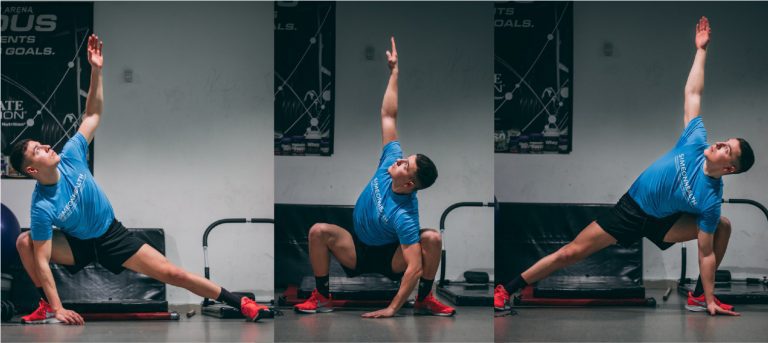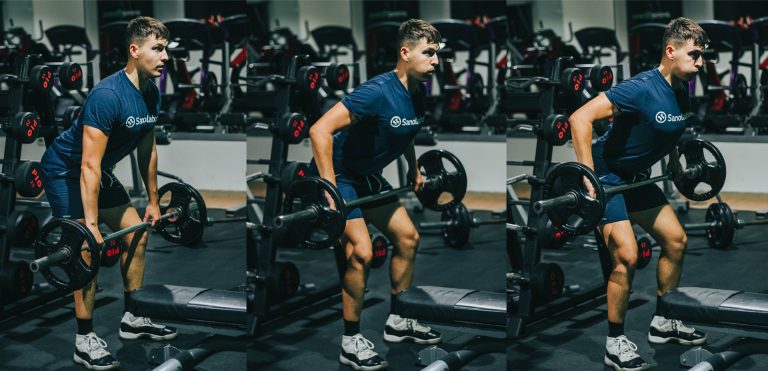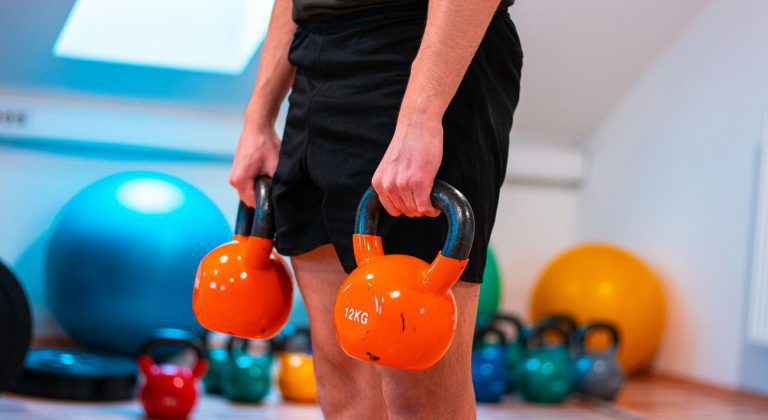How to Train for Hypertrophy & Optimize Testosterone Levels
Each training protocol has a specific goal in mind. There is a major difference between doing slow or fast reps, doing positives or negatives, and doing 10+ or fewer reps, so knowing how to train for hypertrophy will make the difference.
If you want to train for hypertrophy, you have to learn the main factors associated with muscle growth. All these factors like testosterone levels, optimal diet & sleep, type of training or training method, type of exercise and rep range as well as rest can significantly impact your results in the gym. There’s also a common relationship between testosterone and weightlifting, you do not want to miss on.
What is Hypertrophy?
Hypertrophy in strength training translates to the growth of your muscle fibers. This results in increased muscle mass, which brings strength or power gains.
During hypertrophy, we initiate certain mechanisms in our body that support the growth of our muscles. They can only grow two ways, by hyperplasia or hypertrophy. Hyperplasia is a dividing process meaning we end up with more muscles than before training. The thing is, hyperplasia only amounts to around 2% of the overall muscle growth so it is better to focus on hypertrophy-promoting mechanisms, which amount to 98% of the growth.
Training for Strength vs Power vs Hypertrophy
First of all, let’s define what each individual means.
Strength
Power
Hypertrophy
Training for Strength mainly focuses on one goal: increasing our strength in a specific movement. So we try to produce as much force as we can, independent of time to lift an object from A-Z. Strength training rep ranges vary from 3-6 reps which are also known as heavy weightlifting. This won’t necessarily make your muscle grow most efficiently but it highly affects the weight progressions that enable you to lift heavier in the hypertrophy sessions. Training for strength mainly relies on enhanced neurological transmission.
Training for power mainly focuses on the goal of producing maximal force in the shortest amount of time possible. This too is significantly improved by improving explosiveness or overall neural excitation and transmission. It is toxic to the nervous system, more than to your muscles. As a result of this, you become better at a faster rate of force production. This protocol of powerlifting usually comes at around 1-3 reps and is involving weights higher than 90% RM. Powerlifters may also progressively work up to 8 reps, for additional benefits.
Training for hypertrophy is based on simple principles that can stimulate specific mechanisms in our body which can, in turn, result in greater muscle growth aka an increase in muscle size. The hypertrophy training method will have a higher volume, rep range of 8-12reps, and shorter rest of 60sec. and more controlled movement. If you are interested in why this can optimally stimulate our growth, keep on reading.
The biggest difference between strength or powerlifting to hypertrophy training is:
- Rest time – heavy weightlifting requires more rest time because the goal is not to cause inflammation and increase lactate in the muscle but allow for maximal excitation.
- Type of contractions – Strength & Power is more focused on moving the weight, not so much using the muscle. In hypertrophic training, we try to make the exercise as hard as we can on the muscle.
How does the muscle grow?
When we are training, our muscles undergo certain tension. By lifting weights our muscles undergo microscopic change, being partially teared up. This causes inflammation because cytokines are released in our bodies and there is a build-up of lactic acid. This activates the immune system and satellite cell to start off processes that can repair this damage. Muscles mainly grow through hypertrophy which is increasing the cross-section of the muscle fibers.
Key Point
There are two types of hypertrophy: sarcoplasmic hypertrophy which has more to do with increased lactic acid, intramuscular pressure, and glycogen storage, and myofibrillar hypertrophy which can increase myofibril size.
After the catabolic state of training has finished, our bodies help us to grow and repair in the anabolic state – eating and resting. Also, hormones like Testosterone, HGH, and Cortisol can significantly impact our muscle-building potential. The body responds to the demands you place on it. If you adapt, lift weights, and eat more protein, the muscle will eventually grow.
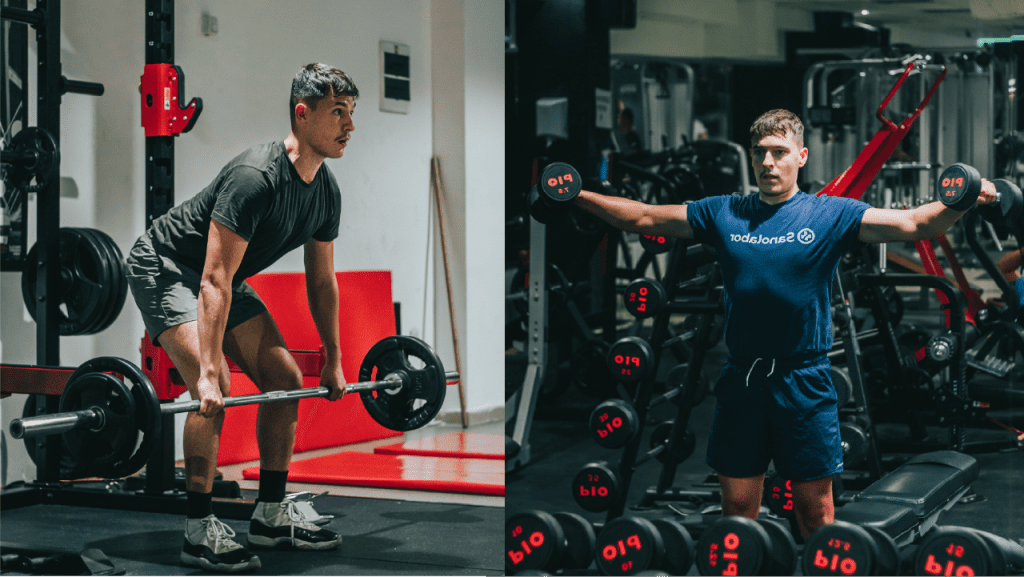
Heavy vs. Light Weightlifting
Both heavy weightlifting and light weightlifting will result in an increase in strength, power, muscle endurance, or hypertrophy. The point is to optimize your training metrics (style) to fit your goals.
The difference between a heavy and lightweight lifting session is clear, it is the load we lift. To further understand critical numbers, well check what RM or rep max % is.
%RM – Rep Max Explained (50% vs 80% vs 100%)
In the strength training literature, a measure of the weight we can push is a percentage of Rep Max.
It goes by the numbers of 50% RM, 60% RM, 85% RM, 100% RM and so on.
This is the percentage of One Rep Max in e specific exercise. For example, If we are able to do one squat with 80kg with a proper form and after a proper warm-up, that is our max. We can’t go over that 80kg with proper form, which means it’s our 100% Rep Max.
Now 50% RM will be 40kg, with which we can theoretically do 50-35 repetitions max.
Each percentage has an optimal and maximal rep range we can do at it, per example.
| % of Rep Max (Load) | Reps You Can Do at each % |
| 95-100% RM | 1-3 reps |
| 85-95% RM | 3-6 reps |
| 75-85% RM | 6-10 reps |
| 65-75% RM | 10-20 reps |
| 55-65% RM | 20-35 reps |
The hypertrophy training, based on science is most optimal when we train with a weight of around 70-80% RM or 8-12 reps on each set.
The reasons for this lie in many factors such as optimal secretion of HGH & Testosterone, best lactate acid production, and inflammation as well as other muscle-tearing concepts.
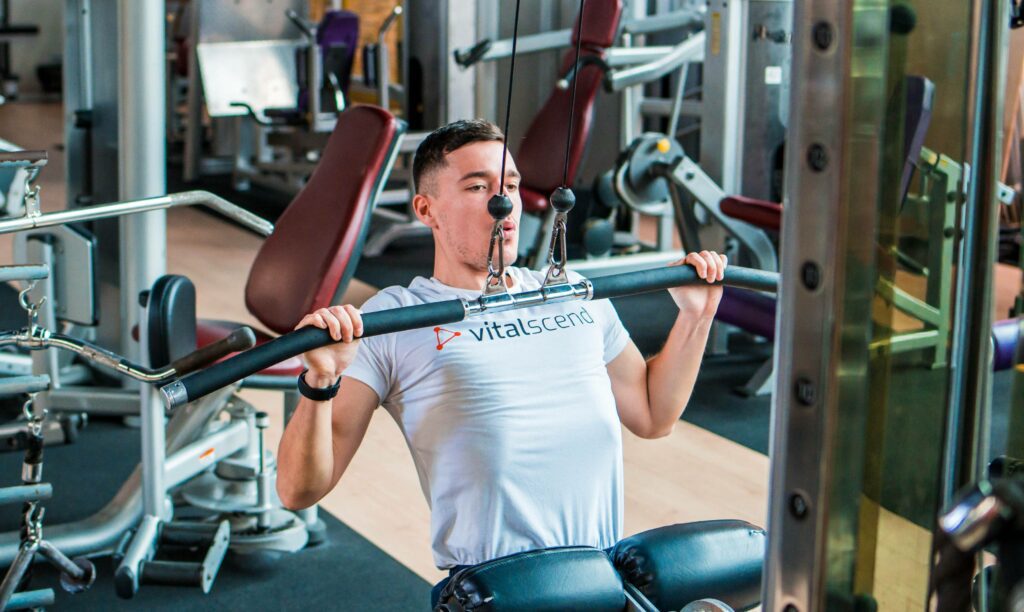
Fundamental Principles of Muscle Growth
In this section, the most important principles of hypertrophy training will be explained. Make sure you check out the studies and see it for yourself. If you are serious about your body transformation, this may pay off in the long run.
Some concepts here are very obvious such as “weightlifting can increase muscle mass” but other concepts like “vitamin D and zinc supplementation can naturally boost testosterone” or myths like “soy is bad for testosterone” will be explained further. Enjoy!
High-Volume Resistance training
- Only three 13 minutes weekly sessions were enough to sustain and maintain muscle strength in 8 week period. It was shown that higher volume was in favor of greater muscle growth. (1)
only three 13 minutes weekly sessions were enough to sustain and maintain muscle strength in 8 week period. The volume is the number of times we train per week, the reps, and sets.
While there are a lot of misconceptions out there about how working way too much is bad for you. For every human, there is a line that once he crosses, he steps into the overtraining or overreaching cycle. The difference is that a professional bodybuilder has worked his way to the 2 hours long lifting session for years.
Volume is a great way to add muscle, but you have a long way to work to a higher volume, it doesn’t just come overnight, it is conditioning.
Muscle Shock Training
Training the same 5 exercises at each session and only switching between muscle groups in a given week can only push you so far. Our muscles need different stimuli.
The muscle is a very complexly structured tissue and it works in many different combined motions and axis than you might think. For example, the best chest exercise you know is the bench press, but what if you do more chest flies, dumbbell bench press, negatives, incline or decline bench press, and so on.
Consider shocking your muscles by throwing in new kinds of workout protocols and types of exercise. Keeping the same level of exercise can get you to platoe and not grow anymore. This is why you should make sure you force the muscle to adapt to new stimuli because everything that is new or different requires more attention from the muscle.

70/30 ratio: Compound vs Isolation
To maximally grow and enhance muscle hypertrophy, you need to hit the muscle on a different axis. You need to learn to use the complex structure that you have, and there is no better way than lifting the majority of your lifts compound.
- Compound weightlifting is doing complex multi-joint exercises with external resistance such as squats, overhead press, weighted dips, or bench press. These multi-joint movements can further increase your testosterone, activate larger muscle groups, and enhance your gains in the gym.
- Isolation on the other side, as shown on Sci-Fit.net has many uses in rehab, muscle imbalance correction, recovery, and injury prevention. Isolation exercises are great to increase lactic acid and maximally pump out the muscles, but usually, they are best in smaller doses at the end of the workout. (2)
Sticking to the 70-30 rule of the compound to isolation training can ensure you hit the basic, most optimal exercise and larger muscle group which can raise your testosterone & strength while also ending up each session with a pump, trying to increase lactate and inflammation in the muscle so it has to adapt.
Two Strategies: Progressive Overload & Hypertrophic Pressure
If we learn how to use both progressive overload and hypertrophic pressure we may be able to further increase our muscle mass. What this basically means is using a combination of workouts tailored to improve our strength, but dominantly focusing on hypertrophy workouts.
The logic behind it is when you are training for hypertrophy, you are causing high inflammation, more cytokines, and lots of lactate. Your body has to fight against this to regenerate your muscles but after 4 weeks it needs a break. If you take a no-workout break week you will mostly lose half of your gains at the start.
Biohack
Cvery 4th week train for strength, or at least closer to strength with rep ranges of 3-8 reps, 2-3 sets lifting heavier weights like 90% RM. I know at first it seems contradictory to lift more weights on your “rest” week but the point is that you are exercising different mechanisms. Most of this 90% RM will affect your muscle activation working on your nervous system adaptation instead of causing anatomical fatigue to your muscles.

Improve your Sleep
Research shows that sleep deprivation can lead to loss of strength and muscle. (3)
Even acute sleep deprivation was shown to reduce skeletal muscle protein synthesis and muscle-building hormones. (4)
Low quality of sleep is also associated with lower HGH and Testosterone which are some of the main anabolic hormones which play a major part in regeneration and muscle growth.
There is even evidence that sleep-deprived participants in a 2020 study have had lower rates of muscle protein synthesis in comparison to the control group. (5)
If you want to really grow your muscles, it turns out that sleep and proper regeneration can be highly efficient.
Some of the main reasons why low-quality sleep or sleep deprivation is detrimental or can slow down muscle growth are the lower rates of HGH and testosterone secretion, reduction in energy and increase in fatigue, hormonal imbalances, and lower muscle protein synthesis.
This is logical since the main regeneration processes happen while we sleep. Sleeping is the time when the biggest portion of HGH is released, the main hormone for regeneration and growth.
Tips to Improve Sleep
- Reserve 9 hours of bedtime every night
- Keep a strict schedule you respect 6 out of 7 days
- Try to go to bed from 10, 11, or 12, since 11-2 is the highest rate of melatonin secretion or deepest sleep cycle.
- Make sure you sleep in a distraction-free, Bluetooth-free, dark room with fresh air.
- A hot bath, Magnesium, Massage, or Meditation pre-sleep can also help with relieving tension.
- Consider Natural supplements like Valerian Root, Passionflower fruit, or Lavender tinctures.
High Intake of Protein
The average human with a sedentary lifestyle needs around 50 grams of protein, dependent upon age, sex, genetics, and so on. This amount is okay for muscle maintenance in average humans. If you are training, however, this amount cannot be sufficient to support muscle growth. So, how much is enough?
The basic Muscle-Growth Protein Requirement recommendation is 1 gram of protein per pound of body weight which is 2.2 grams of protein per kilogram of body weight.
The reason why there isn’t a one-fits-all recommendation is that there is a major difference between overweight individuals trying to lose fat, a younger skinny athlete trying to grow muscle, and a lean bodybuilder on a caloric deficit diet.

Yes, while the 1 gram per pound is a good overall recommendation, there are few factors you want to consider such as your body composition, fat-free mass, full caloric intake, and fitness goals.
Per overweight person at 150 kg eating 2.2 grams per kg equals 330 grams which is absolute overkill, way too high. On the other side, a 70kg athlete with 12% body fat will highly benefit from 2.2 grams per 1kg of weight, at around 150 grams per day.
Extra Research: How Much Protein is Enough?
- 2.3 grams per kg was superior to 1 gram per kg for young healthy athletes during short-term weight-loss. (6)
- Absorption-wise, it is smarter to eat more meals with 0.4g protein (a meal) per kg of bodyweight spread in 3-5 meals, rather than having all your protein in 1-2 meals a day. This rule applies if you want to further support muscle growth anabolism optimally, and muscle protein synthesis. (7)
- For Athletes, 1.3-1.8 grams per kg is optimal, while going higher such as 1.8-2.0 during caloric deficit may help with preserving lean muscle mass and prevent loss. (8) The higher the intensity, volume, and training, the more fat-free mass we have, we aim for more protein.
So the best solution is to calculate your Fat-Free Mass or FFM and adjust your protein accordingly. If you calculate your FFM, you should aim for around 2 grams of protein per kg of body weight while if you count on your full body weight, you should go for 1.6 optimally.
The point is that during weight training you want to keep your protein high at around 1.2 – 2.2 per kg of body weight, which is the normal range.
Do HIIT instead of Slow-Long Cardio
When trying to build muscle and lose fat at the same time, one of the most common mistakes people make is long cardio sessions. While it’s unfair to say that bodybuilders don’t do so, professionals have completely different regimes, so it’s best to not compare yourself.
- HIIT or high interval intensity training has been shown very effective in different studies on fat loss, insulin resistance, glucose tolerance, and skeletal muscle fat oxidation. (9)
The effects of aerobic training are definitely huge for heart health and efficient for weight loss. The problem is muscle growth is an anabolic process while long cardio sessions cause a higher and longer rate of catabolism in the body. This means that maybe the muscle you worked so hard to gain you are now wasting it.
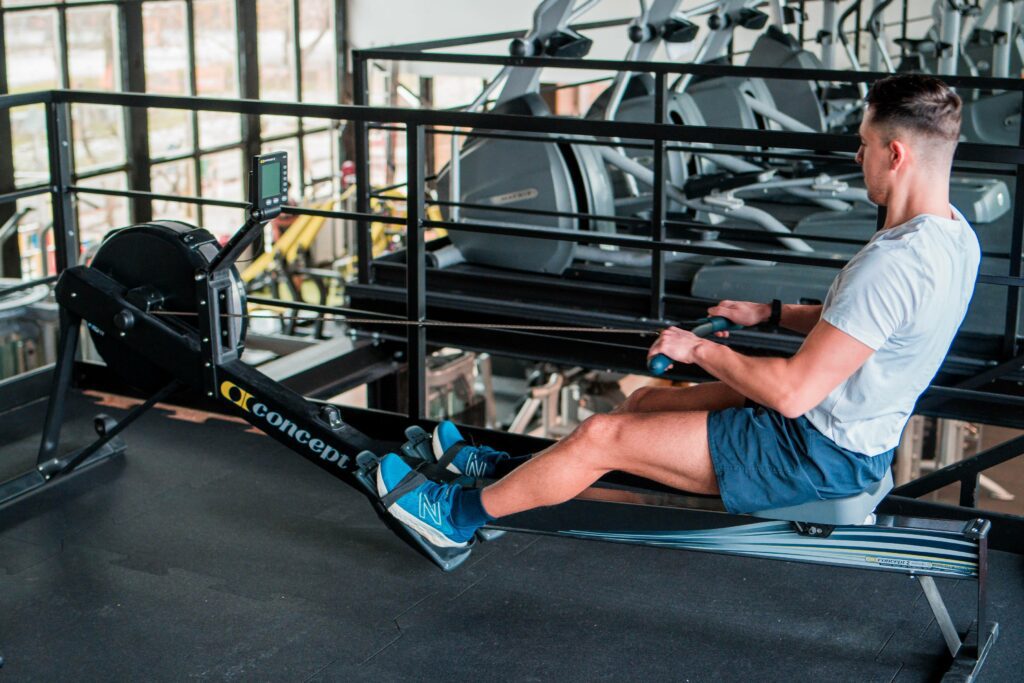
People are not built to be bodybuilders and marathoners at the same time. Strong, Lean people usually have more white-fast twitch fibers activated, trained, and hypertrophied while runners, swimmers, and bikers work on the aerobic activity of their slow-twitch muscles.
This doesn’t mean you shouldn’t swim or run if you want to build muscle but if your main goal is fat loss and muscle growth, HIIT is great supplementation before or after weight lifting sessions to get the heart rate up, speed up your metabolism and cause an after-burn effect.
The Hypertrophy Method
The best Weightlifting Method for Muscle Growth is the standard, Hypertrophy method.
| Warm-up Protocol | Functional Warm-up using light cardio and mobility movements |
| Training | A high volume of training, 6 days a week, hitting large muscle groups twice weekly |
| Type of Contraction | Aim for both concentric and eccentric contractions, and do all reps in a controlled manner |
| Exercises | Use a combination of dominantly compound (70%) and isolation (30%) exercises |
| Muscle Groups | Push-Pull-Legs Routine: – Push muscles (chest, triceps shoulders) – Pull Muscles (Rear Shoulder, Mid, Upper, and Lower Back) – Legs (Quadriceps, Hamstrings, Glutes, and Calves) twice weekly |
| Sets | Aim for 3-4 sets per exercise, three exercises per muscle group, which is 10 sets/muscle per workout, 20 in total per week. |
| Reps | Aim for 80% RM (weight) and 8-12 repetitions. Do them in a slow, controlled manner completely engaging the muscle. |
| Rest | Duration of rest should be 60 seconds between exercises, you may take one 3 minute break at the half of your workout |
How to Boost Testosterone and HGH Naturally
For further gains, optimizing your hormonal environment and naturally boosting your main muscle-growth supportive hormones is the key.
key point
The four main hormones responsible for muscle growth are Growth hormone (GH), Insulin-like Growth Factor-1 (IGF-1), Testosterone, and Insulin. Of course, there are various other hormones that are involved in the process of both muscle tearing and muscle growth & regeneration.
The natural process of weightlifting itself takes care of the elevation of these hormones.
Research has found that acute response of increased hormonal secretion during or right after exercise is crucial for tissue regeneration and growth. Testosterone was elevated 15-30 minutes post-resistance exercise which is an initial stimulus for muscle growth. (10)
One of the most important findings of this study was that the highest hormonal elevations were present when the exercise protocol was: high in volume, high in intensity, had short rests, and stressed large muscle mass. This is why we highly recommend the standard hypertrophy method for mass.
- On average, testosterone levels range from 264 ng/dL to 916 ng/dL in non-obese men. (11)
A paper published in 1996 in the “New England Journal of Medicine” shows the effect of testosterone administration and exercise on muscle size and strength gains. It seems that testosterone (exogenously) was effective, but the effect was significantly improved by strength training.
How long does it take to see muscle growth?
Although the effects of weightlifting will acutely result in visible muscle increase, this isn’t really building muscle. At the end of each weightlifting session it is normal that we look more muscular than at its start. This is caused by increased circulation and water-pulling effect of creatine. In reality, we need around 3 months to significantly build muscle. Shorter periods of training will mainly aid in water-retention and won’t build real muscle, resulting in easier visible muscle loss after quitting weightlifting training.
How much protein per day for muscle growth?
The ideal protein quantity to build muscle is 1.2-1.7 grams of protein per kg of bodyweight daily. If you measure in pounds, this will amount for 0.5-0.8 grams of protein per pound of bodyweight.
Should I train to failure for hypertrophy?
Training to failure is an effective method for hypertrophy. The basic idea relies on the fact that muscle contractions tear up smaller muscle fibers and cause microtears, which is the main stimulus for regeneration. Training to failure will ensure this happens, and also increase lactic acid build-up. This causes inflammation, after which with sufficient protein, rest and regeneration the body is building more and stronger muscle fibers.
4 Ways to Boost Testosterone Naturally
To naturally boost testosterone, besides training consistently with the hypertrophy method we can also do these 4 things.
Zinc & Vitamin D
Optimize Your Sleep
Reduce Body Fat %
Maca / Ashwagandha
Whether that’s eating more fish, dairy products, nuts, and poultry or getting more sun, or supplementing with it, increasing the levels of zinc and vitamin D, especially in those who are deficient can significantly impact testosterone levels. (12)
Since even a one-week sleep restriction of 5 hours per night has led to a reduction in testosterone levels by 10-15% in young healthy men, optimizing your sleep might be a good way to restore or even boost natural testosterone levels. (13)
Overweight people have lower testosterone in general. Keeping our body fat at 10-15% which for most people will be a reduction of body fat, can help us to increase testosterone levels. Going too high or too low on body-fat is not favorable for a testosterone boost, so a sweet spot is around 10-15%.
Research has shown that higher levels of testosterone in 252 men were associated with leaner bodies. (14)
Natural supplements like herbs or adaptogens that have been studied for their effects on libido and testosterone are maca and ashwagandha. Take into account that further research on herbs is needed to prove that this will actually increase gains. In overweight males Ashwagandha was shown to increase DHEA-S levels and Testosterone, (15) while Maca may improve sexual desire without affecting serum testosterone levels. (16)
Conclusion
- Hypertrophy training – can be enhanced by following some proven principles, which are mostly associated with the type of training and nutrition. Undoubtedly, resistance weight training at high volume, eccentric controlled contractions, and short rests are the go-tos for muscle growth.
- Protein, Sleep & Training – supporting your growing muscles with protein, especially Leucine is very important. Improving your Sleep, switching to HIIT than long Cardio, and Supplementing with Zinc or Ashwagandha/Maca might enhance your results, boost testosterone, and speed up regeneration. As for training, 8-12 reps, 3 sets, 65-85 %RM gives the best results, in terms of muscle growth.
Frequently Asked Questions
What is the most effective way to build muscle?
There are three core principles to building muscle. First is training, and the most practical one is hypertrophy method, which aims for high volume of 4-6 workouts per week, 6-12 exercises per workout, 3-5 sets of 8-12 reps with a load of 65-85% RM. Slow, eccentric and controlled lifts, minimal rest of 45-60 seconds in between. The other two factors are high-protein diet (especially Leucine, BCAA & Glutamine) and optimal sleep/regeneration.
What is Hypertrophy?
Hypertrophy is muscle growth. The growth of muscle fibers in size. It is one of the main mechanism behind increasing muscle size, being superior to hyperplasia, which is increase in the number of muscle fibers
How to train to increase muscle size?
To increase muscle size we need to focus on hypertrophy training method. This includes high volume, moderate loads and short rest periods. More specifically, you should aim at metrics such as: 5-6 workouts per week, 6-12 exercises per workout, around 3-5 sets per exercise with 8-12 reps of 65-85% RM Load. Rest periods shouldn’t exceed 1.5 minutes in between. Optimal recovery, sleep and regeneration alongside with high protein diet are crucial too.



